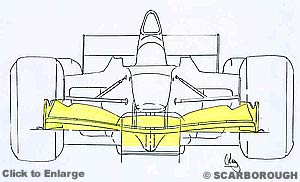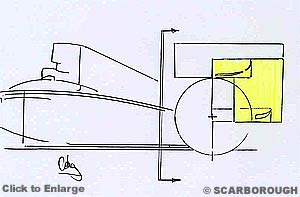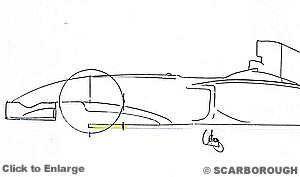
Atlas F1 Technical Writer
The three proposals put forward by FIA's Charlie Whiting last week have serious ramifications for the F1 teams for next season. Craig Scarborough reviews the alternatives and lays out the pros and cons for each option
This week the FIA's technical delegate Charlie Whiting put forward three proposals to the Technical Working Group (TWG). The three packages are in essence:
Package1: Front wing raised and draconian engine restrictions
In formulating the rules the emphasis has clearly moved to slowing the cars down, rather than mere cost cutting. Indeed, should all the original post Indianapolis changes have been combined, the cost for teams and engine suppliers would have been prohibitive.
The rules have been put forward to the TWG as a choice of three packages, each offering a choice of two major changes. The pairs of changes range from bitterest pill plus a sweetener, to a pair of mildly tolerable chassis alterations. Clearly some provocative political manoeuvring is the FIA's aim, as the extremes in each pair of changes sees the teams interests set against the engine manufacturers.
Allied to the teams'/manufacturers' inability to gain any kind of consensus of agreement, the FIA have toyingly offered to consider a combination of the packages. It would be unlikely they would accept a combination of the simpler options. By anticipating the teams and manufacturers conflict of interests the FIA have put forward one solution as the most likely to be preferred solution.
The proposed packages
Package One: dramatic front wing restrictions, and severe engine restrictions
The engine changes will restrict the manufacturers to a fixed bore, cylinder spacing, crankshaft height and mounting positions, effectively reducing the innovation possible to design smaller engines and tune the motor by means of bore/stroke ratios. The far reaching impact of a raised front wing and the prospect of fixed engine specs would be unattractive to team and engine suppliers alike. I doubt this option will be adopted in full or part.
Package Two: restricts the space for the diffuser, and moves the rear wing forwards 15cm, allied to a strict enforcement on bodywork deflection
Body work and wings must not flex more than 10mm when a vertical load of 500n (Newtons) is applied; this would force teams to build much more robust flip ups and winglets ahead of the rear wheels (items behind the double arrowed line). Overall rear downforce will be lost, but not to the same dramatic level as that for the front wing in Package One. While this is not desirable, the impact of changing the rear wing at this stage in the 2005 cars development is more attractive than changing the front wing. With no engine impact this package is the most likely to be accepted by the major teams and engine manufacturers, but offers the smaller customer teams very little.
Package Three: simple revisions to the bodywork rules and simple engine revisions, with a critical proviso
Every manufacturer will have to provide an option for a free supply of competitive engines to two other teams, with a notice period of one full season year before pulling out of any agreement with a team. This is good news for Jordan, Minardi and Sauber, but the major engine manufacturers will not like its impact. The teams will not be troubled too greatly by the longer floor and loss of bargeboards, and downforce/drag would barely be affected.
Supplementary rules
In addition to the three options above, the FIA have asked the TWG to accept two sensible rules changes based largely on safety.
Firstly, a limit has been proposed on the use of certain materials likely to cause sharp debris following a crash; how this could be implemented has not been clarified. A different form of carbon composite could theoretically be used in the construction of wings and bargeboards, or perhaps a return to metallic material for wishbones, or some other measures to reduce the shattering of the brittle materials used for these parts. There will be quite a debate in deciding the solution to this rule, as the teams will not want to let go of their favoured carbon fibres.
Secondly, a reduction in the weight limit has been proposed to reduce the amount of ballast run to correct and tune the cars weight distribution and centre of gravity. Currently teams run between 50 and 100kg of dense Tungsten ballast; this forms between 8-16% of the cars total weight, and is viewed as a hazard, as the ballast is often placed in the protruding splitter at the front of the car; in accidents or over kerbs this can be misplaced, creating a potential hazard.
It would be unlikely the FIA could ban the use of ballast; many teams now prefer not to run as much ‘removable' ballast, but rather manufacture extra heavy components such as engine sumps and monocoque floor to add the weight low down but still gain the benefit of a low centre of gravity. Should 50 kg or more be knocked off the cars minimum weight, the FIA have accepted a reduction in tyre width to correct the static load on the tyres.
Whether this would speed up of slow cars down is a matter for debate. On one hand the front tyres would be loaded less, which could either reduce the overloading of the tyre (speeding up cornering) or reduce the mechanical grip (slowing the cornering). Factoring in the raising of the car's centre of gravity, and potentially the rearward weight bias (most ballast is placed at the front), the cars would need to have quite a different mechanical layout to overcome those problems. Either way, without a corresponding reduction in power, acceleration would be increased. As ever, over time the teams would bring lap times back up to current levels.
Over the race weekend in Indianapolis this year the FIA announced that new rules concerning aerodynamics and engines would be introduced in 2005-2006. The detail of what they wanted, and how many of the proposed changes would finally be incorporated, was vague. Clearly the teams had a greater level of information, as they knew the approximate changes to the areas bodywork affected.
Package2: Rear wing moved forwards and more stringent deflection tests
Package3: Simple bodywork changes and a move to 2.4 litre V8 engines
 Raise the front wing by 10cm either side of the step, keeping the middle section at the current 5cm. This would be another increment on the front wing changes seen for the 2000 season, and would severely reduce front downforce, forcing the teams to run less downforce at the rear to compensate. Complicating this solution for the teams would be the impact of the higher front wing on the aerodynamic flow all the way back along the car.
Raise the front wing by 10cm either side of the step, keeping the middle section at the current 5cm. This would be another increment on the front wing changes seen for the 2000 season, and would severely reduce front downforce, forcing the teams to run less downforce at the rear to compensate. Complicating this solution for the teams would be the impact of the higher front wing on the aerodynamic flow all the way back along the car.
 Some complex exclusion zones for bodywork have been added, to restrict the placement of bodywork (i.e. wings) ahead, below and above the rear wing. The package leaves a restricted space to place the rear wing (pictured in yellow), moving the upper elements forwards by 15cm in the process, but with similar restrictions to those currently on the number of aerofoil elements and endplate size. Interestingly the diffuser appears untouched by these regulations, and the area that can contain wings is limited to a span of 96cm, hence the last 2cm on either end of the wing is exempt and can have a longer chord, albeit for limited downforce benefit, and at the cost of drag.
Some complex exclusion zones for bodywork have been added, to restrict the placement of bodywork (i.e. wings) ahead, below and above the rear wing. The package leaves a restricted space to place the rear wing (pictured in yellow), moving the upper elements forwards by 15cm in the process, but with similar restrictions to those currently on the number of aerofoil elements and endplate size. Interestingly the diffuser appears untouched by these regulations, and the area that can contain wings is limited to a span of 96cm, hence the last 2cm on either end of the wing is exempt and can have a longer chord, albeit for limited downforce benefit, and at the cost of drag.
 This package extends the flat bottom forward to the front wheel axle line (pictured in yellow), and bans bargeboard and turning vanes (although how these are defined and where they can be placed has not been clarified). The engine restrictions will be limited to capacity and cylinder, 2.4litre V8s, as expected, but this rule also comes with a sporting rule to force teams to provide competitive engine supplies.
This package extends the flat bottom forward to the front wheel axle line (pictured in yellow), and bans bargeboard and turning vanes (although how these are defined and where they can be placed has not been clarified). The engine restrictions will be limited to capacity and cylinder, 2.4litre V8s, as expected, but this rule also comes with a sporting rule to force teams to provide competitive engine supplies.
|
Contact the Author Contact the Editor |
Please Contact Us for permission to republish this or any other material from Atlas F1.
|
Volume 10, Issue 36
Articles
Exclusive Interview with Eddie Jordan
The Tifosi and the Samurai at Monza
Technical Analysis: 2005 Proposals
2004 Italian GP Preview
2004 Italian GP Preview
Italian GP Facts & Stats
Columns
The F1 Trivia Quiz
Rear View Mirror
Bookworm Critique
On the Road
Elsewhere in Racing
> Homepage |